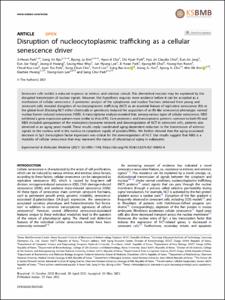Disruption of nucleocytoplasmic trafficking as a cellular senescence driver
- Title
- Disruption of nucleocytoplasmic trafficking as a cellular senescence driver
- Author(s)
- Park, Ji-Hwan ; Ryu, Sung Jin ; Kim, Byung Ju ; Cho, Hyun-Ji ; Park, Chi Hyun ; Choi, Hyo Jei Claudia ; Jang, Eun Jin ; Yang, Eun Jae ; Hwang, Jeong-A ; Woo, Seung Hwa ; Lee, Jun Hyung ; Park, Ji Hwan ; Choi, Kyung-Mi ; Kwon, Young-Yon ; Lee, Cheol-Koo ; Park, Joon Tae ; Cho, Sung Chun ; Lee, Yun-Il ; Lee, Sung Bae ; Han, Jeong A. ; Cho, Kyung A. ; Kim, Min-Sik ; Hwang, Daehee ; Lee, Young-Sam ; Park, Sang Chul
- Issued Date
- 2021-06
- Citation
- Experimental and Molecular Medicine, v.53, no.6, pp.1092 - 1108
- Type
- Article
- Keywords
- APOPTOSIS ; CELLS ; EXPRESSION ; IDENTIFICATION ; CLEARANCE ; INDUCED PREMATURE SENESCENCE ; TRANSCRIPTION FACTOR SP1 ; REPLICATIVE SENESCENCE ; DOWN-REGULATION ; STRESS
- ISSN
- 1226-3613
- Abstract
- Senescent cells exhibit a reduced response to intrinsic and extrinsic stimuli. This diminished reaction may be explained by the disrupted transmission of nuclear signals. However, this hypothesis requires more evidence before it can be accepted as a mechanism of cellular senescence. A proteomic analysis of the cytoplasmic and nuclear fractions obtained from young and senescent cells revealed disruption of nucleocytoplasmic trafficking (NCT) as an essential feature of replicative senescence (RS) at the global level. Blocking NCT either chemically or genetically induced the acquisition of an RS-like senescence phenotype, named nuclear barrier-induced senescence (NBIS). A transcriptome analysis revealed that, among various types of cellular senescence, NBIS exhibited a gene expression pattern most similar to that of RS. Core proteomic and transcriptomic patterns common to both RS and NBIS included upregulation of the endocytosis-lysosome network and downregulation of NCT in senescent cells, patterns also observed in an aging yeast model. These results imply coordinated aging-dependent reduction in the transmission of extrinsic signals to the nucleus and in the nucleus-to-cytoplasm supply of proteins/RNAs. We further showed that the aging-associated decrease in Sp1 transcription factor expression was critical for the downregulation of NCT. Our results suggest that NBIS is a modality of cellular senescence that may represent the nature of physiological aging in eukaryotes. © 2021, The Author(s).
- Publisher
- Springer Nature
- Related Researcher
-
-
Lee, Yun-Il 바이오메디컬연구부
- Research Interests
-
- Files in This Item:
-
 기타 데이터 / 3.9 MB / Adobe PDF
download
기타 데이터 / 3.9 MB / Adobe PDF
download
- Appears in Collections:
- Department of New Biology Laboratory for QBIO and Precision Medicine 1. Journal Articles
- Well Aging Research Center 1. Journal Articles
- Division of Biotechnology 1. Journal Articles
- Department of New Biology Senescence-Associated Mechanism Lab 1. Journal Articles
- Department of Brain Sciences Laboratory of Neurodegenerative Diseases and Aging 1. Journal Articles



